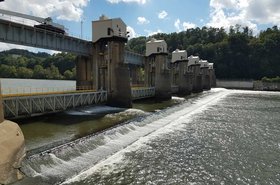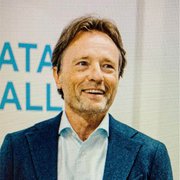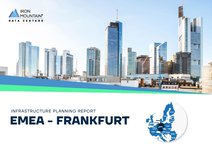Not surprisingly, there has been a lot of discussion of the emerging planning constraints and power shortages in Frankfurt. But if you look at the fundamentals, both retail and (particularly) hyperscale space are enjoying higher demand than in virtually any other European metro. And this demand will continue to be met, as I’ll try to explain.
Demand and supply: Neck and neck
First, some figures for this year: According to JLL’s latest EMEA Data Centre report, Frankfurt is set to continue to grow rapidly with 118MW-worth of space forecast to be added in 2023, a 20 percent increase year-on-year. CBRE estimates an even higher figure of 147MW, the most of any FLAPD market.
Despite the rate of build-out, vacancy rates show just how neck and neck supply and demand are just now. CBRE reckons that Frankfurt’s vacancy rate will finish below four percent by the end of the year, one of the lowest rates ever in the European market, and about half of the next most space-squeezed major market (Dublin).
Add stricter government regulations, development and power constraints to this and you can see why some people might worry about future development. Land prices continue to soar and power availability is now so tight that some officials are saying there will be no more power available in central Frankfurt for over a decade.
Why Frankfurt?
Why is Frankfurt so popular? Well, as the home of the European Central Bank, the German central bank, and the German stock exchange, it is one of Europe’s leading financial centers. It is also an excellent strategic gateway to Eastern Europe. The availability of capital accelerated technology start-ups fuelled broader growth, and Frankfurt quickly became Germany’s ICT infrastructure hub, with peering provided by DE-CIX, one of the largest internet exchange points in the world.
I believe take-up in Frankfurt was the highest of all the hubs in 2022. Brexit, while it didn’t slow London’s growth, led a lot of people to colocate in both London and mainland Europe simultaneously, and concerns about the moratorium on data center builds in Amsterdam made Frankfurt a better bet at this time.
Expanding the envelope
If you have land and power for data centers in central Frankfurt you are very lucky. When we acquired our FRA-1 and FRA-2 sites there was some debate over the price, but all 27MW of FRA1 sold extremely quickly, in one of the largest wholesale deals in the history of European colocation.
On the retail side, our 11MW FRA-2 facility, which we acquired from Keppel, had plenty of capacity in Am Martinszehnten, 18 minutes from the airport and the city center. This facility has proved hugely popular with retail and enterprise customers, and is filling up fast.
Which leads us to the next phase of Frankfurt’s growth. We are now actively searching for a third facility, and like many providers we are looking further afield, in surrounding cities and towns as the Frankfurt interconnection hub expands beyond the city.
As an example of this, Mainz seemed too far away only two years ago, but now is part of the Frankfurt hub, as are Offenbach and Hanau to the east. New hyperscale cloud availability zones are key to this expansion, as they create denser fiber routes and connectivity ecosystems. Customer impact is minimal. They still sit on top of the Frankfurt fiber backbone, and distances are small compared to places like the USA; just 15 or 20 kilometers. This means that proximity is not an issue for any but the most millisecond-sensitive.
There is nothing new about this. In the Netherlands, for example, new facilities are springing up to the east of Amsterdam in Diemen and Almere. When we set up our facility near Haarlem to the west, people questioned whether this was really an ‘Amsterdam’ facility.
The success of AMS-1 has justified our decision, and it is underlined by a growing number of competitors setting up around us under the Amsterdam banner. We wish them a warm welcome to the neighborhood.
In New York you can see a similar pattern, with a limited number of businesses happy to pay a premium for Manhattan, while the majority enjoy lower rates and plenty of space and power in places like New Jersey with our NJE-1 facility.
Overcoming constraints
The constraints and regulations that Frankfurt City Council is proposing have still not been finalized. Restricted development zones, obligatory PUE metrics and heat sharing have been proposed, among other things.
The German Data Center Association (GDA), while keen to cooperate on sustainability measures, has pointed out that the allocated areas may be either inappropriate or incapable of meeting demand.
The GDA also pointed out that, while data centers use five percent of the commercial space in Frankfurt, they provide 70 percent of Germany’s digital services.
In my view all sensible sustainability obligations should be supported and common sense will prevail, in order to keep the doors open for data centers in the region as they represent both critical infrastructure and crucial investment.
Looking forward
For the foreseeable future Frankfurt will still be one of Europe’s leading hubs. Colocation and cloud providers are all scouting for space here, but they are casting their nets a bit wider, and they can still expect great returns.
For customers, while prices are higher, the premium they pay is still a small proportion of total investment, and will guarantee them a presence with room to grow in one of the world’s most desirable and fastest-growing connectivity and service provider clusters.
Find out more: IMDC infrastructure planning report
If you are interested in knowing more about the Frankfurt colocation market, take-up levels, weaknesses, opportunities and threats, the Iron Mountain Data Centers team has put together a very useful download: Infrastructure planning report EMEA: Frankfurt.
More from Iron Mountain Data Centers
-

Sponsored Data centers: Invisible engines of change
A look at the data center’s impact on society
-

5 key implications for information lifecycle management
Keeping data secure throughout its lifetime
-

Iron Mountain signs 24/7 PPA to draw hydroelectric power from existing US dams
Rye Development will add generation capacity in the US mid-Atlantic region


